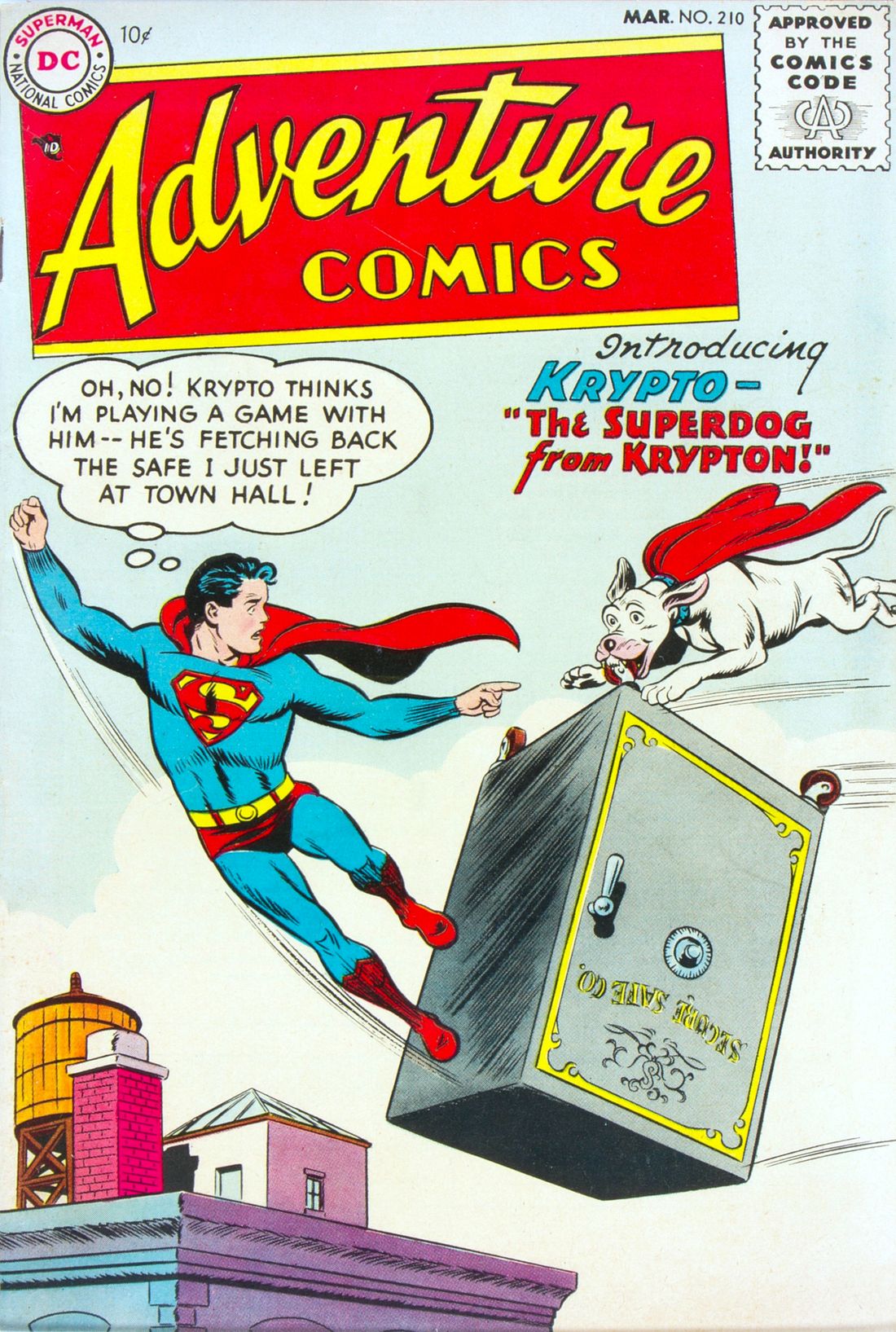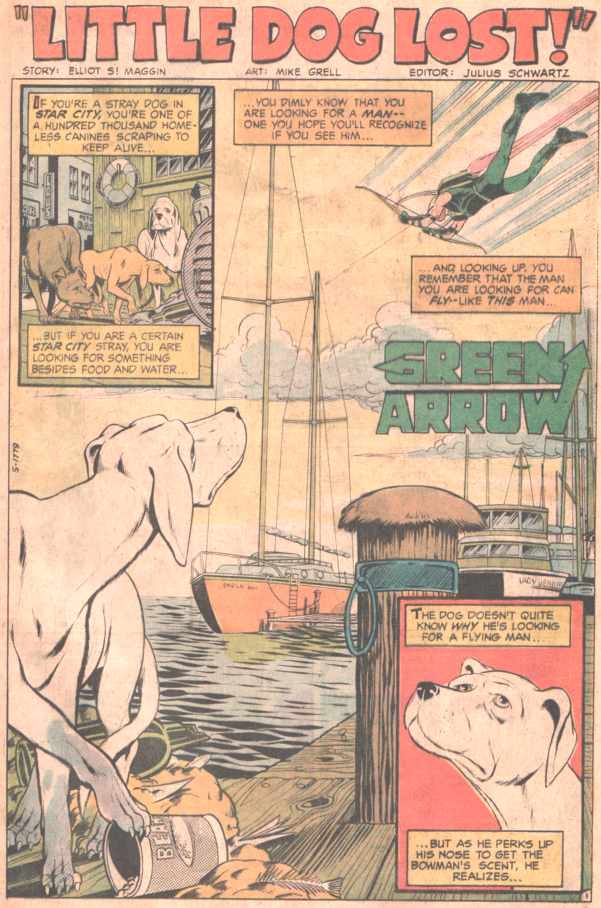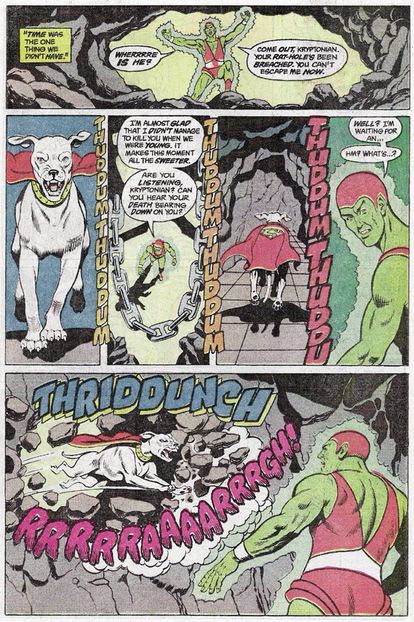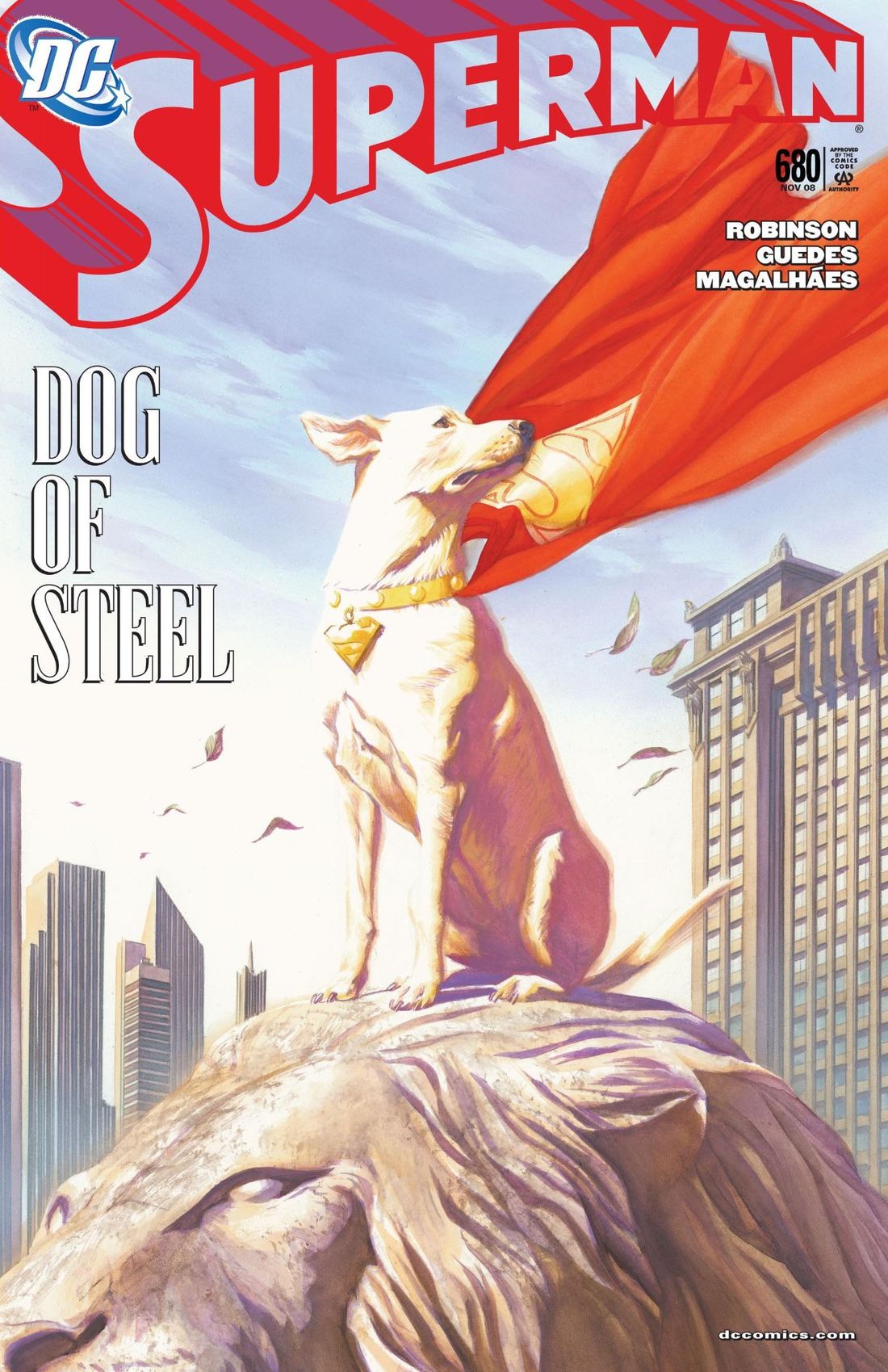
Before the trailer for James Gunn’s Superman featured Krypto dragging Superman out of a crater, comic book enthusiasts had always recognized that he was, above all, a good dog. Yes, he could destroy houses and Fortresses of Solitude with equal ease, and yes, he’s been subjected to more editorial changes and reboots than any pet deserves, but Krypto has consistently symbolized the optimistic spirit of DC Comics. Just like Superman, even from outer space, Krypto serves as a reminder of our shared humanity.
Over the years, Krypto has symbolized a picture of Rockwellian America – a place where a virtuous man owns a loyal dog and welcomes the extraordinary science fiction found in a canine donning a cape and displaying superpowers. His path to the big screen, however, wasn’t without its challenges. To truly appreciate DC Comics’ most noble canine making his grand entrance (and flight) into blockbuster territory, it’s crucial to comprehend the heroic obstacles that Krypto’s character had to overcome. In 2025, Krypto will be turning 70; there’s no need to calculate this age in Superdog years!
Adventure Comics No. 210 (1955)

Krypto, a dog, entered comic books’ pages in “Adventure Comics” as an experiment by Jor-El, Superman’s father. Interestingly, Krypto was sent into space two years after the first canine in space but was published after some primates had already been launched. It’s worth noting that instead of risking his own son Kal-El in an untested rocket, Jor-El opted to test it on animals first. Consequently, Krypto arrived in Earth’s orbit years following Kal-El’s crash-landing. Initially, in his early appearances within “Adventure Comics”, Krypto served as a humorous animal sidekick to Superboy, whose adult adventures were typically featured in different comic books.
Oh dear, “Oh, no!” Superboy exclaims on the cover of Krypto’s first issue. “Krypto believes I’m playing a trick on him – he’s retrieving a safe that I just left at the town hall!” In essence, Krypto is a mischievous pup, a trait that Gunn utilizes as Krypto playfully wrestles with Supes in his latest movie. Adventure Comics would give birth to several DC staples: It introduced the Legion of Superheroes and started planting the seeds for the concept that Lex Luthor first encountered Clark Kent during his teenage years. And while creators Otto Binder, Curt Swan, and Sy Barry only intended for Krypto to make a single appearance, the dog proved to be quite persistent.
Adventure Comics No. 293 (1962)
The 1960s are often seen as a challenging period for DC Comics. Many of its characters were subjected to extravagant storylines that made Batman, portrayed by Adam West, seem restrained. However, Krypto managed to endure this era quite well. In fact, he had already adopted a secret identity during this time; the Kent family knew him as “Skip.” Additionally, he was given his own team, known as the “Legion of Super-Pets.
In various comics that had some connection to Superman, who served as a playground for DC writers’ most imaginative concepts, several “super-pets” were born. For instance, Streaky the Super Cat was actually Supergirl’s pet, and Beppo the Super Monkey was a stowaway on Kal-El’s rocket en route to Earth. Interestingly, the Legion of Super-Pets was jointly created by Jerry Siegel, one of Superman’s co-creators who was struggling financially with his DC Comics work in the 60s. However, this animal alliance didn’t persist for long. As other DC characters were undergoing their own version of a reboot, Krypto seemed to be among the casualties of the changing tone for a while.
The Adventures of Superboy episode 1: “The Spy From Outer Space” (1966)
https://youtube.com/watch?v=watch?v=SZeJRpq_fzU
In the initial season of “The Adventures of Superboy,” which often accompanied “The New Adventures of Superman” in a collection of cartoon shorts, Krypto first appeared on screen, even if it was only by a week over his adversary Lex Luthor. This animation series, created by Filmation, a studio known for its cost-effective production methods, usually featured Clark Kent, still in high school, skipping class to help or be helped by Krypto in various predicaments, confronting villains, or averting disasters.
The animated series might seem crude in appearance. Filmation often repeated animations excessively during transitions between main scenes. However, the inclusion of Krypto, not just as a supporting character but a major one in the show, marked his transition from the obscure comic book realm into mainstream culture. While Krypto wasn’t as widely recognized as Luthor, it would no longer be surprising to learn that Superman is fond of dogs.
Action Comics No. 440 (1974)

In this contemporary period of DC Comics, the most notable change is the reworking of Batman, making him less reliant on his quirky devices and eccentric adversaries, restoring him to his role as a brooding nighttime crusader. Similarly, Superman experienced a transformation, albeit not as drastic, leading to a few years without Krypto by his side. Upon Krypto’s return, he was accompanied by amnesia, adding a grittier element to his adventures. The first character to identify him was Green Arrow, who, like many others, had been reimagined for renewed significance.
By the next year in Superman No. 287, Krypto would recover his lost memories. (In The Krypton Companion, writer Elliot S. Maggin stated, “A superman needs a dog. A superman needs a superdog.” Later, Maggin penned the charming novella Starwinds Howl, which detailed Krypto’s origin from Krypto’s perspective.) However, throughout that period, Krypto remained something of an unusual character for many readers. For several issues of The Superman Family in the late 1970s, he was portrayed as a wandering adventurer – a lone superhero, “Kapper” the detective dog, and even a movie star. But Krypto’s brush with Hollywood stardom wouldn’t end there.
Superman: Whatever Happened to the Man of Tomorrow? (1986)

If the previous explanation doesn’t clarify, it was quite challenging for DC Comics to manage their rich history and imaginative tales in line with their story goals. To tackle this issue, they introduced the epic storyline known as “Crisis on Infinite Earths“, where numerous worlds were destroyed, and many key characters met their demise. After streamlining their universe, DC entered a period called the “Post-Crisis” era. However, people wondered about Krypto: Where did he end up?
Alan Moore’s farewell story, “Whatever Happened to the Man of Tomorrow?“, beautifully merged the whimsical space adventures with deep emotions, and even paid a poignant tribute to Superman’s cherished pet. In this narrative, Superman, under attack by the Legion of Super-Villains along with Lex Luthor (who was fused with Superman’s longstanding adversary Brainiac), Krypto confronted an irradiated villain known as the Kryptonite Man. He ended the menace by … tearing out his throat. However, kryptonite poisoning from this encounter, which would have severely affected Superman, took a toll on Krypto and led to his heart-wrenching death, marking one of the saddest moments in comic book history.
The Adventures of Superman Volume I No. 502 (1993)
Following the fateful battle between Superman and Doomsday in the renowned “Death of Superman” storyline, DC Comics found themselves in an even more tumultuous situation than typical. Among the subsequent tales, several prospective successors emerged, such as Kon-El, Superman’s clone who adopted the name Superboy. Additionally, one character striving to combat crime was Bibbo Bibbowski, a regular bar patron and ardent Superman fan. After saving a tiny white puppy, he decided to christen it “Krypton.” Unfortunately, the individual creating the dog’s identification tag made an error, leading us to know the pup as “Krypto.
This less powerful version of Krypto, resembling James Gunn’s compact design, wasn’t particularly effective in fighting crime. Essentially, it seems that the creators may not be eager to bring back the superpowered Krypto, as writer Karl Kesel suggested, “I’d like to see the caped canine, but I’m not sure DC shares the same sentiment. Don’t get your hopes up.” Over time, despite serving as Superboy’s pet, the dynamic between them was underwhelming, and efforts to establish this version as a main character didn’t take off. Eventually, they decided to abandon Krypto altogether.
Superman Adventures No. 40 (2000)
You might expect, given the extensive scope of the DC animated universe, that we’d see more of Krypto the Superdog beyond just occasional appearances. However, despite writer Paul Dini expressing a desire to incorporate Krypto into various stories (“I bought every comic book featuring Krypto simply because he was cool,” Dini said, reminiscing about his childhood fondness for the character), producer Bruce Timm consistently vetoed the idea, apparently stating, “It’s quite good, but NO KRYPTO!!”. Nevertheless, in the Superman Adventures comics, which Timm considered non-essential, we were eventually treated to a peek at Superman’s Best Friend.
In the realm of critically acclaimed DC Animated Universe (DCAU) productions, this one delivers an amusing and poignant experience. The mischievous Mr. Mxyzptlk brings Kal-El’s canine companion to Earth, and let me tell you, he’s a double-edged emotion-packed package. It would have been delightful to witness Superman bonding with Krypto under happier circumstances; however, the finale, where Superman must return Krypto to his own time, is genuinely heart-wrenching. This bittersweet ending subtly conveys that Krypto may not belong in this universe, which adds a layer of melancholy to the tale. Yet, it’s commendable that the creators handled the situation with the gravity and sincerity that losing a beloved pet deserves.
Action Comics No. 776 (2001)
As a devoted cinema enthusiast, I must say that John Byrne’s reinterpretation of Superman in the late ’80s was met with considerable praise, but it seems subsequent writers have found it challenging to grasp the implications for Superman’s origins stemming from this reinvention. Byrne portrayed Krypton as a sterile and uncaring society, which left future writers with a conundrum: either rewrite Byrne’s narrative or devise some sort of exception – perhaps an alternate universe Krypton, a dream, or an illusion? It’s quite the balancing act when you’re striving to innovate while still staying true to the established lore.
The initial appearance of the super-powered Krypto occurred post-Crisis in Action Comics issue 776. In this comic, it becomes a challenge comparable to Brainiac’s intellect to determine if he is actually Kal-El’s pet from the genuine Krypton. This revamped version of Krypto exhibits immense power and unruly behavior, causing Superman some trouble in training. This amuses Superman’s associates like Batman, who find it entertaining that Krypto often behaves as an adorable, chaotic creature that Superman must manage. (Gunn seems to appreciate the concept of a troublesome yet lovable Krypto for Superman to deal with.) Furthermore, this canine is inclined towards heroics, making him a permanent addition to the storyline despite the frequent changes in Superman’s backstory.
Smallville, season four, episode 14 “Krypto” (2005)
https://youtube.com/watch?v=watch?v=9l-zoBwySRQ
In Smallville, which spanned ten seasons, it followed two distinct sets of guidelines: Superman couldn’t showcase his flying abilities or wear a cape, but every teen drama-worthy emotion was openly displayed. This makes the introduction of “Krypto”, a superpowered dog, seem quite unusual. When you introduce a character with extraordinary powers like Krypto, it implies a willingness to bend some rules. However, Krypto’s live-action debut leaves room for a touch of cartoonish excitement, and provides Tom Welling, our longstanding heartthrob portraying Superman, with something intriguing that doesn’t necessarily lead to a love triangle.
It’s been revealed that Krypto is actually one of LutherCorp’s experiments, and fortunately, Clark manages to resist when Lex tries to reclaim the dog. The dog’s powers disappear, along with any traces of his original name. Clark wishes to call him Krypto, but his family prefers the more fitting “Shelby” for Smallville. Smallville frequently employed this tactic, introducing a beloved character, only to alter them slightly – a clever move. Kudos for including the dog in the storyline!
Krypto the Superdog (2005)
https://youtube.com/watch?v=watch?v=nnHiBOstuUM
Paul Dini didn’t have an opportunity to include Krypto in the DC Animated Universe (DCAU), but together with co-producer Alan Burnett, he created an entirely different animated series titled “Krypto the Superdog”. In this show, a 9-year-old named Kevin owns Krypto, and they work together to combat crime alongside other heroic pets such as Ace the Bat-Hound. Unlike the DCAU where Superman makes brief appearances in the first episode but not reappearing, Krypto takes center stage in this series.
This implies that “Krypto the Superdog” is distinctly childish and shares more of its essence with shows like “A Pup Named Scooby-Doo” than any Superman cartoon from the past 40 years. However, with its array of animal characters, both good and bad, it comes nearer to capturing the excitement of the ’60s Krypto comics than any recent adaptations. As a result, an entire generation of children learned that Krypto could be a main character… or should I say, leading dog.
Superman Volume I No. 680 (2008)

One point of discussion about contemporary Krypto comics is the level of sincerity one should approach him with. Some appearances from the 2000s have a touch of edginess and portray Krypto with an almost skeptical attitude, as if to say, “Wait, Superman has a DOG??” This tone shifted, though, with comics like 2005’s All-Star Superman, which showed that you could create grand, daring stories (even ones featuring a flying canine sidekick for Superman) while still capturing the heart of the narrative. However, the peak of Krypto admiration came in Superman Volume 1 No. 680.
In a heartfelt moment, Superman calls for the attention of Metropolis citizens after he and his canine companion Krypto had defeated Atlas. “If you’re here to applaud a hero,” Superman declares, gesturing at the exhausted Krypto, “THIS is your hero.” He then reveals that the dog by his side is indeed his pet. Surprisingly, Superman adds with a smile, “Now, he’s not just my dog – he’s yours, too.” This heartfelt declaration effectively solidifies Krypto as an integral part of the DC universe, putting to rest any lingering questions about his role and relationship with Superman. No more debating over whether a caped Labrador retriever fits in the DC world – he’s part of it now.
Superman No. 712 (2011)
In the 2010s, DC Comics underwent significant changes, first with “The New 52” rebranding and later with “Rebirth,” and this was also true for Krypto, their canine superhero. Over time, Krypto’s character had become more stable, shifting from a variety of personas reminiscent of Scooby-Doo or Air Bud, to a reliable “good dog.” Although he still occasionally showed destructive tendencies by tearing up doors occasionally, his devotion was unwavering. This devotion extended not only towards Superman but also to Superboy and Supergirl, two characters with whom he formed strong bonds.
In Superman issue 712, the deep bond between Krypto and Superboy is evident as Krypto grieves for his recently deceased friend. This story, which took time to be published, was written years before the New 52 reboot would eventually reshape Krypto’s origin (and later with Rebirth, returning Krypto to a past similar to his Silver Age persona). As Joey Esposito noted for IGN, “Anyone who has ever had a connection with a dog… will find it challenging not to shed at least one tear.” Despite the complicated changes in comic book continuity, Krypto’s heart-wrenching quest to find his lost friend remains impactful. In the end, all that is left for poor Superdog is to cling to memories of his fallen companion.
Superman Red and Blue Volume 1 No. 5 (2021)
Accepting Krypto as a character also implies accepting a particular depiction of Superman – one that remains optimistic despite his attempts to uproot worldly cynicism. The comic anthology Superman Red and Blue showcases this image, and while the Krypto story in issue 5, “Fetch,” is another origin tale for Krypto, it uses Krypto (and thus Superman) as a symbol of the transformative power of pure goodness on a troubled spirit.
Modern depictions of Clark Kent often emphasize his youth as a rather solitary period, not to the extent of Peter Parker’s torment, but with a sense of existential doubt and a feeling of being an outcast. The unexpected arrival of Krypto from Kal-El’s destroyed planet in a crashed rocket signifies to Clark: There are others like you who exist, though it may take time to find them, you will eventually belong among them.
DC League of Super-Pets (2022)
https://youtube.com/watch?v=watch?v=1jkw2JPCl18&pp=0gcJCfwAo7VqN5tD
The film DC League of Super-Pets originated from a chaotic phase in DC movie production, often referred to as “let’s try everything and see what works.” It’s quite plausible that a studio executive approved this project with the intention of creating a costumed-IP equivalent of the The Secret Life of Pets franchise.
However, despite the movie’s narrative – centering around a dog struggling to fit into their owner’s life but ultimately discovering their unique value – feeling somewhat predictable, there’s an intriguing layer of self-reference in Krypto’s journey that adds depth.
The film’s concept originated from Director Jared Stern’s experiences volunteering at an animal shelter, where he observed people frequently overlooking older animals, just as Krypto has been repeatedly overlooked. Like Krypto, the character is often reintroduced to fit contemporary trends, only to be discarded when those trends change. A new writer finds a way to incorporate Krypto into the story, but this lasts only as long as the current comic-book narrative trend. Eventually, Krypto is sent back to the shelter, waiting for adoption. However, in modern stories such as 2017’s Super Sons Annual No. 1, Krypto has become more welcomed due to their embrace of the inherent playfulness of “super pets”. When people prefer a darker, more serious approach to their superheroes, supporting characters like Krypto are often the first to be phased out. The movie DC League of Super-Pets underscores that there’s always a place for a loyal canine companion in our lives.
Superman (2025)
James Gunn’s Superman is a skillful blend of different Superman periods, incorporating the dramatic shifts in tone from the Silver Age comic books, the Post-Crisis stories that questioned and challenged established facts about Superman’s mythos, and modern tales like All-Star Superman that seamlessly integrate various elements and themes with heartfelt authenticity. Moreover, Krypto, modeled after Gunn’s real-life dog Ozu, is present, and his inclusion reflects a creative journey that started in 1955, combining the evolution of both the comic books and movie adaptations.
In the world of comics, Krypto has endured numerous revisions and alterations over generations, firmly establishing himself as Superman’s constant companion. While most Superman films have tended to stick to familiar ground from the DC universe, Gunn recognized the need to venture off the beaten path and delve a bit deeper. In the latest Superman film, Krypto serves as a bridge between these two narratives, offering comic relief, an adventurous spirit, and a dash of emotional depth. After being around for 70 years, it’s about time that the movies gave him a well-deserved spotlight.
Read More
- Who Is Harley Wallace? The Heartbreaking Truth Behind Bring Her Back’s Dedication
- 50 Ankle Break & Score Sound ID Codes for Basketball Zero
- Lost Sword Tier List & Reroll Guide [RELEASE]
- 50 Goal Sound ID Codes for Blue Lock Rivals
- KPop Demon Hunters: Real Ages Revealed?!
- Umamusume: Pretty Derby Support Card Tier List [Release]
- Basketball Zero Boombox & Music ID Codes – Roblox
- 100 Most-Watched TV Series of 2024-25 Across Streaming, Broadcast and Cable: ‘Squid Game’ Leads This Season’s Rankers
- The best Easter eggs in Jurassic World Rebirth, including callbacks to Jurassic Park
- How to play Delta Force Black Hawk Down campaign solo. Single player Explained
2025-07-11 21:56